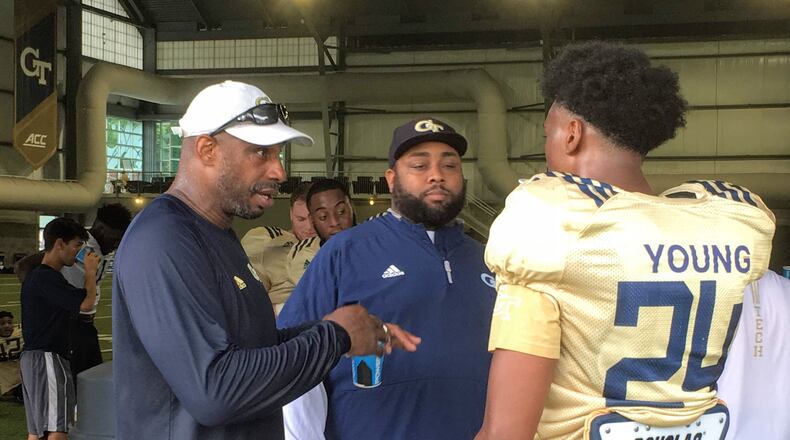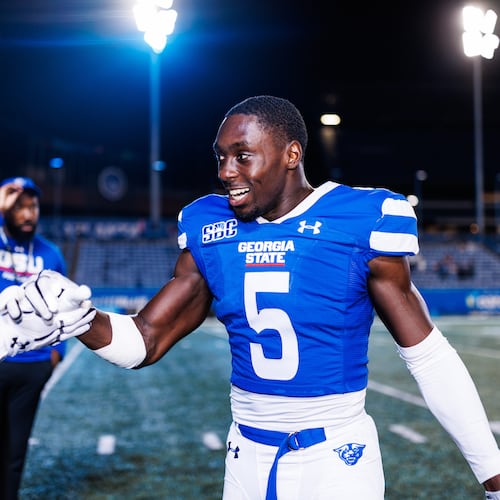The challenge before Marco Coleman, Georgia Tech’s assistant coach over defensive ends and outside linebackers as well as the Yellow Jackets’ legend in residence, is not a difficult one to figure out.
As Coleman led his players through practice Tuesday, they were 10 in number. Of the 10, three were freshmen – Chico Bennett, Sylvain Yondjouen and Kendall Young. Another four were redshirt freshmen – Justice Dingle, Jordan Domineck, Luke Johns and walk-on Curtis Ryans. Of the remaining three, junior Antonneous Clayton is a transfer from Florida whose eligibility for this season is uncertain, and Kelton Dawson is a sophomore who played in two games last season, making junior Jaquan Henderson the veteran by default. Henderson has 19 games to his credit, none in a starting capacity.
Coleman loves their effort. He said he probably has one of the hardest-working position groups on the team. But he recognizes that, to produce on the field, effort doesn’t get the job done by itself.
“Just, again, the lack of experience, which is to be expected,” Coleman said. “I mean, they’re freshmen, redshirt freshmen. Even me, when I was a redshirt freshman, I didn’t know what the heck was going on.”
Given the different strengths and weaknesses of players and the likely inconsistency that younger players will demonstrate, Coleman will take a flexible approach to playing time.
“Whoever’s hot that day is going to roll with it,” Coleman said.
He said that Henderson, a converted linebacker, has made the strongest case to play, no surprise given his advantage in experience and speed on the edge.
“He’s standing out and having a pretty good camp,” Coleman said.
Henderson has embraced the switch to defensive end, made in the spring.
“Being a linebacker, I kind of had to think a lot, but this (position) right here allows me to use my ability against offensive tackles and lets me play fast,” Henderson said. “And that’s the main thing with me. I like playing fast.”
If Clayton, who has applied for an immediate-eligibility waiver, is allowed to play, he’s likely a strong candidate for playing time. He has been disruptive in his 11-on-11 work thus far in the preseason.
Bigger players like Clayton play defensive end on one side of the line. Dingle is over there, too. “Tweener” types, players with body types somewhere between outside linebacker and defensive end, are better fits for the rush end spot at the other end of the line. They include Henderson and Domineck.
Some players, such as Dawson, are at both. Coleman said that he has had “a great start to the camp.”
As at other position groups, Coleman, defensive coordinator Andrew Thacker and coach Geoff Collins are having to figure out who will be “above the line,” Collins’ term for players who are expected to contribute in games.
“Right now, we’re just working through who are going to be the guys that we feel like we can count on,” Coleman said. “If it’s two, it might be two. If it’s eight, then it’s eight. It’s just a matter of who we feel we can trust.”
With the youth, it’s a group that probably will be fearsome in two years as players build strength, gain experience and develop skill. But, as for 2019, such a young and untested group enters the season with uncertainty over their expected productivity. Particularly given the important role that the ends play in pass rush in pressuring quarterbacks off the edge, how quickly Coleman can develop his players will have a bearing on how the Jackets’ season takes shape.
For a variety of reasons, pass rush has not been a strength in recent seasons for the Jackets. In the final five seasons of coach Paul Johnson’s tenure, Tech ranked 108th or lower in sacks per game in FBS.
“We’ve got a long way to go,” Coleman said. “By no means am I saying that we’ve arrived at any point. But they’ve progressed, and their progress is pretty good.”
Dingle has found motivation in the low expectations.
“We’re very anxious to go out there and just prove that we can compete,” he said.
About the Author
Keep Reading
The Latest
Featured


